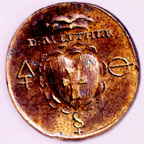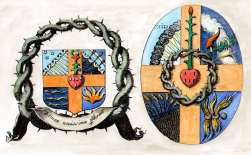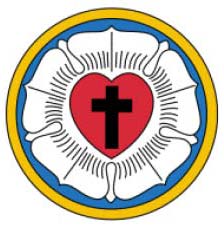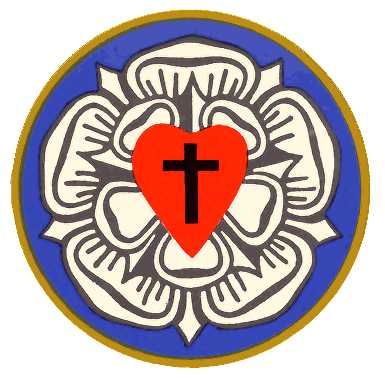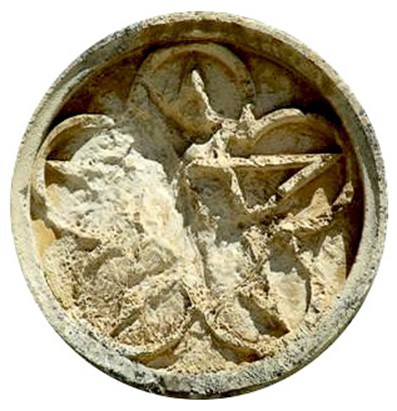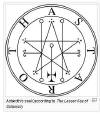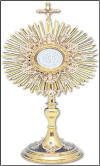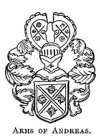“A word then about Wycliffe’s anti-clericalism, a
factor now so much stressed as one of the causes of the sixteenth century
Reformation. Anti-clericalism did not begin with Wycliffe or in England: it
existed in France at the beginning of the fourteenth century. It spread from
the south French university of Montpellier, a
great law school, which trained most of the anti-clerical courtiers and
ministers of Philip IV...
“To sum up, then: Wycliffe’s translation of
the whole Bible was an undertaking with a political side: the lay party
could use it against the clericals: disendowment was in the air. But the
spiritual side of Wycliffe’s intention was much the stronger. He desired to
put the clock back: to restore the Church to her poor and primitive state.
He had no realisation that in destroying the
institutions of the Church of his day he might be endangering the Christian
religion itself...” (Margaret Deanesly,
The Significance of the Lollard Bible)
The purge of the Knights Templar occurred from 1307 to 1314
at which time the Merovingian Pope and his curia were setting up their
headquarters in Avignon. John Wycliffe was born in 1327 and entered the
political scene around 1376, at the close of the Avignon Papacy and onset of
the Great Schism. Wycliffe may have been an agent of the network of the
secret societies that Henry Saint Clair had established on the British
Isles. According to Prince Michael Stewart, President of the European
Council of Princes, said to be a constitutional advisory body to the
European Union, following the Templar purge on the Continent, the Celtic
Church of Scotland welcomed the refugee Knights Templar who then formed the
Order of the Rosy Cross. The first order of business of the Knights of the
Rosy Cross was to meet with the Pope at Avignon.
“The established Roman Church may have betrayed the Templars, but
in Scotland they found something far more trustworthy and tangible: a sacred
royal house, and a Priest-King of the Celtic Church succession. ...the Knights
became part of the Scottish Government as the appointed Royal Bodyguard, with
the Order established as ‘Guardian of the King of Scots by day and by night’...
A new order was then formed, called the Elder Brothers of the Order of
the Rosy Cross, and several of the Rosy Cross Knights then sailed to France for
a meeting with Pope John XXII at Avignon.
“Many historians have presumed therefore that the Knights
Templars must have been disbanded in Scotland, but this was not the case; it was
simply that [Robert the] Bruce had contrived the secret Order to become even
more secretive. Indeed, the Order of the Knights of the Rosy Cross...was a very
successful cover.” (The Forgotten Monarchy of Scotland, p. 65)
Having formed the secretive Order of the Rosy Cross in
Scotland, the Templars sent a contingent of Rosy Cross Knights to France for
a meeting with the Pope at Avignon. This is documented with a footnote: “The
Vatican Archives, Rome” What would prompt the persecuted Templars to return
to the headquarters of the Catholic Church which had martyred many
knights of their Order? The high-level meeting between the fugitive Templars
and the Avignon Pope reeks of collusion. The Templars’
newly-formed Order of the Rosy Cross had been absorbed into the Celtic
Church of Scotland, and it is with the Celtic Church of Scotland that a
connection to John Wycliffe is found. On the website of
The Bible Museum, Inc., a source
for rare and antique Bibles, is a chronological history of the English
Bible. A section of this history, titled “The Pre-Reformation History of the
Bible,” states that a secret society known as the Culdees “chose John
Wycliffe to lead the world out of the Dark Ages.”
“On the Scottish Island of Iona, in
563 AD, a man
named
Columba started a Bible
College. For the next 700 years, this was the source of much of the
non-Catholic, evangelical Bible teaching through those centuries of the Dark and
Middle Ages. The students of this college were called ‘Culdees’, which means
‘certain stranger’.
The Culdees were a secret society,
and the remnant of the true Christian faith was kept alive by these men during
the many centuries that led up to the Protestant Reformation…
“In the late
1300’s, the secret society of Culdees chose
John Wycliffe to lead the world
out of the Dark Ages.
Wycliffe has been called the ‘Morning Star of the Reformation’…
“…It was not as a teacher or
preacher that Wycliffe gained his position in history; this came from his
activities in ecclesiastical politics, in which he engaged about the mid-1370s,
when his reformatory work also began. In 1374 he was among the English
delegates at a peace congress at Bruges. He may have been given this position
because of the spirited and patriotic behavior with which in the year 1366 he
sought the interests of his country against the demands of the papacy. It seems
he had a reputation as a
patriot and reformer;
this suggests the answer to the question how he came to his reformatory ideas.”
(Greatsite.com)
According to The Bible Museum, Inc., the name “Culdee” means
“certain stranger,” however, according to the
Ancient Order of the Culdees of Iona, the word means “Chaldea,” as in
ancient Babylonia: “Origin of the word Culdee. The
name Culdee comes from Chaldee, (Chaldeans pronounce the word Chaldee as
Kaldee or Culdee), in the sense that it alludes to Abraham the Chaldee, who
left his home, worldly wealth, kindred and idol making to find the Promised
Land.” The 1611 King James Version used the word “Caldees” with
reference to the Babylonians or “Chaldeans,” which was the updated spelling
in later editions.
See:
The Lollard
Movement: Avignon Papacy: John Wycliffe
“We
often think of Martin Luther lighting the torch of
the Reformation, but the Czechs have the oldest Reformation tradition in
mainland Europe. Long before Luther nailed his theses to the door of
Wittenberg Church in 1517, the Czechs had established their own national
Protestant church with their own vernacular Bible and hymn book. In 1406
or 1407 and perhaps as early as 1385, Czech students studying at Oxford
brought back to Prague the writings of John Wyclif.
“The
rector of Charles University in Prague, Jan Hus (1372?-1415), a man of
outstanding intellectual gifts and personal integrity, took up Wyclif’s
ideas. In particular, he took up the belief that, in true remembrance of
the Last Supper, the Communion, or Eucharist, should be given in both
kinds—bread and wine. The chalice became the symbol of the Hussite
revolution, and Hussite supporters were often referred to as ‘Utraquists,’
meaning ‘in both kinds.’ Jan Hus was a great scholar and a gifted
preacher. Between 1402 and 1403 the Bethlehem Chapel in the Old Town
district of Prague was regularly packed, standing room only, with people
eager to hear him expound on the Bible in their own Czech tongue.
“In
1412, Antipope John XXIII declared war on Naples and, to raise money,
instituted the practice of selling indulgences — official forgiveness by
the Church. Hus was outraged and was promptly excommunicated for his
protest. Outlawed from Prague, Hus wandered about the countryside
preaching and spreading Reformation ideas throughout the country. In
1415 the Council of Constance invited him to explain his views and
promised him safe conduct. It was a trap: on false charges he was
condemned as a heretic and burned at the stake on July 6, 1415. It was
his birthday he was just forty-three years old. Jan Hus began, and
Comenius continued, even in exile, the reformed
group that came to be called the Unitas Fratrum (the Unity of
Brethren), also now known as the Moravian Church, which still exists
with a worldwide following. Its formation was formalized in 1457, and it
is the oldest of all Protestant churches, with its own hymn book (1505)
and Czech-language Bible.”
(The
Rosicrucian Enlightenment Revisited, p. 201)
“Prague became
a Mecca for those interested in esoteric and scientific studies from all
over Europe. Hither came John Dee and Edward Kelly, Giordano Bruno and
Johannes Kepler. However strange the reputation of Prague in the time of
Rudolph it was yet a relatively tolerant city. Jews might pursue their
cabalistic studies undisturbed (Rudolph’s
favourite religious adviser was Pistorius, a Cabalist) and the native
church of Bohemia was tolerated by an official ‘Letter
of Majesty’.
The Bohemian church, founded by John Huss, was the first of the reformed
churches of Europe. Rudolph’s toleration was
extended to the Bohemian church and to the Bohemian Brethren, a mystical
brotherhood attached to its teachings. Prague under Rudolph was a
Renaissance city, full of Renaissance influences as they had developed
in Eastern Europe, a melting pot of ideas, mysteriously exciting in its
potentiality for new developments.”
(Francis Yates, The Rosicrucian Enlightenment
(p. 26)
“Wyclif came
from England, they explain, from whom Huss took his teaching, alluding
to Wyclif’s influence on the Hussite reformation.”
(Yates, p. 32)
“[I]n 1546...Rosslyn...chapel’s
centenary year, the Church of Rome was in a bit of a tizzy. Catholicism was
under siege by a new and troublesome adversary—the Reformation. In one fell
swoop, the Christian world was cleft in twain. No longer would Rome be able to raise great armies from its subject nations
to crush heresies wherever the Papal finger pointed. There was no longer
just one big boy on the block. Another had moved in. The mightiest church the world had ever known had been ‘divided’ and
‘conquered’.” - “Rosslyn
Chapel Revisited”
“So
far, we have considered our strategy in our attacks upon the Catholic
Church from the outside. But this is not all. Let us now explain how we
have gone further in our work, to hasten the ruin of the Catholic
Church, and how we have penetrated into her most intimate circles, and
brought even some of her Clergy to become pioneers of our cause.
“Apart
altogether from the influence of our philosophy we have taken other
steps to secure a breach in the Catholic Church. Let me explain how this
has been done.
“We
have induced some of our children to join the Catholic body, with the
explicit intimation that they should work in a still more efficient way
for the disintegration of the Catholic Church, by creating scandals
within her. We have thus followed the advice of our Prince of the Jews
who so wisely said:
‘Let some of your children
become canons, so that they may destroy the Church.’ Unfortunately, not all among the
‘convert’
Jews have proved faithful to their mission. Many of them have betrayed
us! But, on the other hand, others have kept their promise and honoured
their word. Thus the counsel of our Elders has proved successful.”
Source: From
a series of speeches at the B’nai B’rith Convention in Paris, published shortly afterwards in the
London Catholic Gazette, February, 1936; Paris Le Reveil du Peuple published
similar account a little later.
(The
Catholic Gazette, February, 1936)
“Although it frequently produced heretics, Italy was no
haven for them; the vast majority of nonconformists of Italian origin
found it possible to survive only by fleeing the vicinity of the pope
and his Inquisition. Among the many classed as heretics by the Roman
church, some were distinctly heretical even by our more exacting
definition. Two of the most influential were an uncle and a nephew,
Laelius and Faustus Socinus
(1525-62 and 1539-1604), whose quest for freedom of thought led them
from Italy first to Rhaetia (modern Graubünden, Switzerland), and then
to Poland. In Poland Faustus took advantage of the nation’s unique
religious tolerance to lay the foundation of modern Unitarianism.
“In contrast to the doctrines of
Hoffman,
Menno, and Schwenkfeld,
these Italian thinkers emphasized not the grandeur of Christ’s humanity,
but its normalcy. Although Servetus had denied the preexistence of
Christ, he acknowledge his divinity as the natural Son of God and died
with a prayer to Jesus on his lips. The Socini were far more
rationalistic and critical. Jesus was a true man–otherwise
he would not have been able to die–and as man he could not have been God. Of course
this is precisely the argument Paul faced when he wrote, ‘Christ
crucified...unto the Greeks foolishness’ (I Cor. 1:23). The reversion to
this line of argument makes it look as though the theological struggles
of the first five centuries of Christianity were all for naught. This
collapse of centuries of laborious theological work within less than
half a century of the outbreak of the Reformation is alarming to those
of us who believe that the Reformation was a necessary corrective to the
doctrinal as well as moral failings of medieval Christianity. It gives substance to the traditional Catholic
charge that the Reformation principles of Scripture alone and private
interpretation open the floodgates to theological chaos. It is
also possible, and in fact to some extent it is even evident, that much
of this rationalistic skepticism, criticism and unbelief was active in
pre-Reformation Catholicism. Luther’s
successful defiance of Rome and the Inquisition released the pressure
seal that had kept skepticism confined, and permitted it to boil over,
but Luther did not create it; it had be brewing for centuries...
“...perhaps we can see in the Reformation era the end of trinitarianism as the unquestioned conviction of Christians.”
(Heresies: Heresy and Orthodoxy
in the History of the Early Church, Harold O.J. Graham, 1988, 2000,
pp. 331-333)

